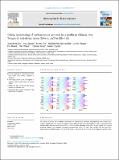Por favor, use este identificador para citar o enlazar a este item:
http://hdl.handle.net/10261/338805COMPARTIR / EXPORTAR:
 SHARE SHARE
 CORE
BASE CORE
BASE
|
|
| Visualizar otros formatos: MARC | Dublin Core | RDF | ORE | MODS | METS | DIDL | DATACITE | |

| Título: | Online monitoring of carbonaceous aerosols in a northern Chinese city: Temporal variations, main drivers, and health risks |
Autor: | Liu, Xiansheng CSIC ORCID; Zhang, Xun; Jin, Bowen; Hadiatullah, Hadiatullah; Zhang, Luyao; Zhang, Pei; Wang, Tao CSIC ORCID; Deng, Qihong; Querol, Xavier CSIC ORCID | Palabras clave: | Organic carbon Black carbon Carbonaceous aerosols Health risk assessment |
Fecha de publicación: | 1-ene-2024 | Editor: | Elsevier | Citación: | Atmospheric Environment 316: 120169 (2023) | Resumen: | This study examined the variability and source of carbonaceous aerosols, encompassing total carbon (TC), organic carbon (OC), and secondary organic carbon (SOC) for the years 2019–2020, as well as equivalent black carbon (eBC) and equivalent ultraviolet BC (eUVBC) data spanning 2019–2022, in the context of a typical northern Chinese city: Yanzhou. Averaged concentrations of TC, OC, SOC, eBC, eUVBC, and the ratio (OC/elemental carbon (EC)) reached 11.1 ± 6.7, 8.9 ± 5.1, 3.9 ± 2.0, 3.1 ± 1.3, and 4.3 ± 2.4 μg/m3, and 5.0 ± 2.2, respectively. The concentrations of TC, OC, eBC, and eUVBC were higher in winter, followed by spring and autumn, and summer, while SOC presented the opposite seasonal patterns. The diurnal variations of TC, OC, eBC, and eUVBC exhibited a bimodal pattern with peaks in the early morning (08:00–09:00 LT) and late evening (00:00–01:00 LT) and a trough in the afternoon (14:00–16:00 LT), pointing to vehicular emission and meteorological dispersion as major drivers of the hourly variability. The results obtained from the EC tracer method and minimum R squared (MRS) revealed that r(SOC/OC) were highest in summer (60%) and lowest in winter (26%), showing a fast summer photochemical oxidation of volatile organic compounds (VOCs) that generate SOC. In this study, the influence of meteorological conditions on the weighting of diverse carbonaceous aerosols was quantified using a machine learning method. Results showed that the main drivers of carbonaceous aerosols were height of the planetary boundary layer (HPBL), ambient temperature (AT), relative humidity (RH), and atmospheric pressure (AP) in all seasons. Additionally, the potential health risks of eBC based on the equivalent passive smoking of cigarettes (PSC) suggested that there was a certain level of human health risk in this city. The obtained results will provide more in-depth and comprehensive understanding of carbonaceous aerosol pollution and management strategies. | Versión del editor: | https://doi.org/10.1016/j.atmosenv.2023.120169 | URI: | http://hdl.handle.net/10261/338805 | DOI: | 10.1016/j.atmosenv.2023.120169 | ISSN: | 13522310 |
| Aparece en las colecciones: | (IDAEA) Artículos |
Ficheros en este ítem:
| Fichero | Descripción | Tamaño | Formato | |
|---|---|---|---|---|
| 1-s2.0-S1352231023005952-main.pdf | Artículo principal | 8,76 MB | Adobe PDF |  Visualizar/Abrir |
| 1-s2.0-S1352231023005952-mmc1.docx | Material suplementario | 229,91 kB | Microsoft Word XML | Visualizar/Abrir |
CORE Recommender
Page view(s)
12
checked on 01-may-2024
Download(s)
21
checked on 01-may-2024
Google ScholarTM
Check
Altmetric
Altmetric
NOTA: Los ítems de Digital.CSIC están protegidos por copyright, con todos los derechos reservados, a menos que se indique lo contrario.


